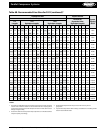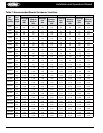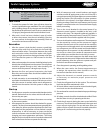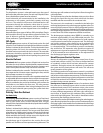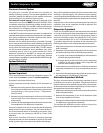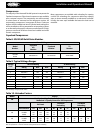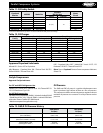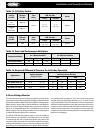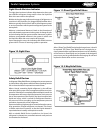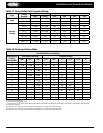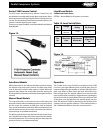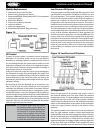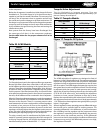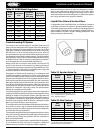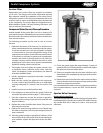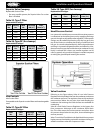
Parallel Compressor Systems Installation & Operations Manual, October 2004 23
Parallel Compressor Systems
Sight Glass & Moisture Indicator
The sight glass/moisture indicator helps determine that a unit
has sucient refrigerant charge and/or when the liquid line
lter drier cores need to be replaced.
Bubbles in the glass may indicate a shortage of refrigerant or a
restriction in the liquid line (i.e. plugged liquid line lter drier).
Moisture typically results from a leak in the refrigerant system
or service operations which open the refrigerant system to the
atmosphere.
Moisture is detrimental because it leads to the formation of
acids which attack components in the system. A change of color
in the indicating dial from green to either chartreuse or yellow
indicates unacceptable moisture in the system in which case
the liquid line lter drier cores need to be changed.
Upon changing the cores, the indicating dial should return to
green within 12 hours of returning system to operation.
Safety Relief Devices
A refrigerant Safety Relief Device is designed to prevent pressure
in a Vessel from rising above a safe limit when operating controls
fail or when the Vessel is exposed to excessive heat.
When a Vessel, containing liquid refrigerant, is shut o from
other parts of the system a rise in temperature will cause a rise in
pressure. If the Vessel is completely lled with liquid a small rise
in temperature will cause a rapid and excessive rise in pressure
due to the expansion of the liquid. If the Vessel contains both
liquid and vapor, which is normal for Refrigerant Receivers,
the pressure will rise according to the temperature-pressure
saturation characteristic of the refrigerant.
If pressure builds up high enough to cause the Vessel to rupture,
large quantities of liquid refrigerant are released. This causes
a sudden reduction of pressure so that the liquid released is
vaporized almost instantly with explosive results.
With a suitable Relief Device installed on the Vessel, the
refrigerant is released at a controlled rate and a safe pressure
is maintained in the Vessel.
After a “Direct Type” Relief Device has discharged once, it should
be replaced. The “Direct Type” Relief Device is designed to re-
close automatically at a predetermined pressure, but reliability
of the Device to reseal tightly and to operate at the designed
pressure can not be guaranteed after discharging. Be safe and
replace the Device after such an occurrence.
Figure 11. Direct Type Relief Valves
Figure 10. Sight Glass
Figure 12. 3-Way Relief Valve



